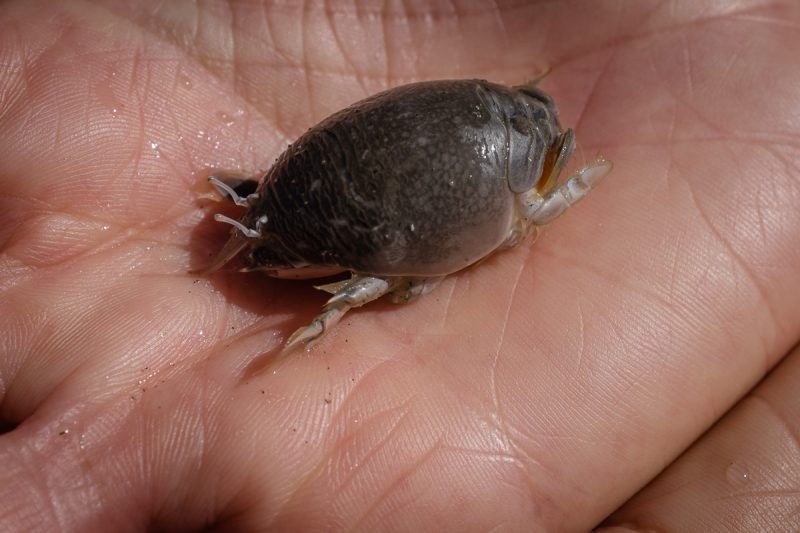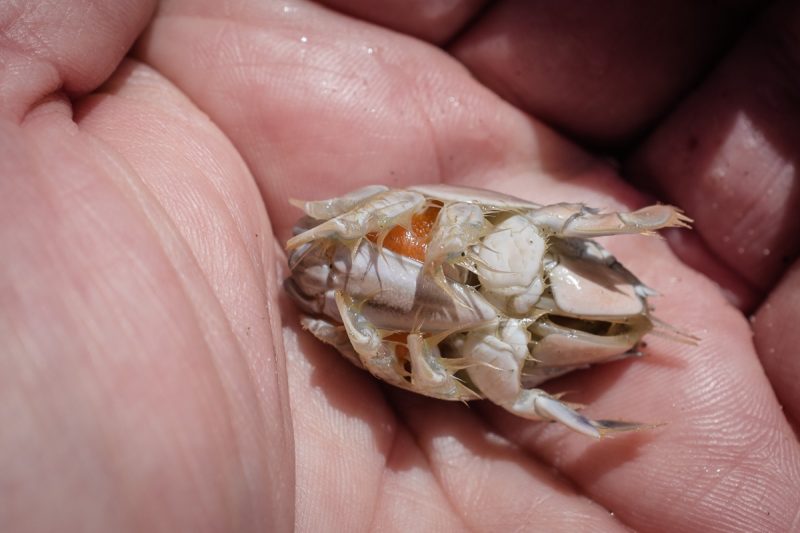I’ve been spending summers out on the west coast since 2006 and I’ve never seen anything like it. Earlier this July, a large number of juvenile Pacific mole crabs made an appearance at Wickaninnish Beach. And they’re still here!

Pacific mole crabs (Emerita analoga) are probably the cutest crab that you’ll ever find in Pacific Rim National Park Reserve and the fact that they’re here in numbers is significant. Following initial records at the edge of a sandy tide pool near the Kwisitis Visitor Centre I’ve found huge numbers on most of the Park’s large exposed sandy beaches—swathes a couple of meters wide and stretching long distances on Florencia, Wickaninnish, and Long Beach.
So what are mole crabs? What do they look like?
According to Aaron Baldwin on eFauna BC:
Mole crabs, in the family Hippidae, are represented by a single species (Emerita analoga) that are normally found only as far north as Oregon. Occasionally (due to larvae transport) colonies will be become established as far north as Kodiak Island, Alaska but these are rare and do not persist. Mole crabs live on high-energy sandy beaches and their presence is usually evidenced by the abundant molted shells in the drift line.
The Pacific mole crab is a sandy-grey, streamlined, oval-shaped crab that lacks the large pincers that we typically associate with crabs. It lives on exposed sandy beaches where it burrows backward into the sand with only its eyestalks visible.

The mole crab is a filter feeder and uses feathery antenna to collect the microscopic dinoflagellates and other small organisms that it eats. Most of the ones that I’ve found on the beaches of Pacific Rim National Park Reserve are a little bigger than thumbnail size. Typically, the size ranges from 10-22mm (males) to 14-35mm (females). Females tend to be found lower in the intertidal zone than males.
Why are they here now?
This is the question that interests me the most—”Why are there so many mole crabs on the beaches this summer?” There are records of large influxes of mole crabs in the past, eFauna BC reports one on Wickaninnish Beach between 1958 and 1960 but none since. Whether this is because no-one was looking for them or because they just weren’t there, could be two possible reasons for lack of records between now and then.

The mole crab lifecycle suggests another possible story. Mole crabs are common on the beaches of California where the population is self-sustaining. Occurrences of large numbers of crabs on beaches of Washington, Oregon, and Vancouver Island appear to be the result of the arrival of larval crabs that have drifted north during the 130 day zoeal stage. Perhaps these new recruits are freshly landed California crabs. Since each female produces 45,000 eggs, a kindly current could bring large numbers to British Columbia.

Another idea (and one that I’m leaning toward) is that water temperatures have warmed up enough that local mole crabs (over the years I’ve found several adult moults) are starting to reproduce. So far this summer I’ve found two females carrying eggs and I’ve heard another report of a third female with eggs. This suggests that things might be more conducive to supporting a self-sustaining population of mole crabs in British Columbia.
Time will tell. Mole crabs have a two year life span. If we continue to see large numbers of mole crabs beyond two years it could be that a new full time resident has joined the locals out here on the west coast.